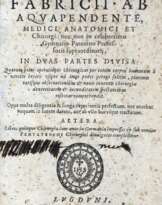ID 887796
Los 23 | De venarum ostiolis, De formato foetu, etc.
Schätzwert
$ 70 000 – 100 000
The fine, wide-margined Blondelet copy of four important works by the father of embryology, including his De venarum ostiolis, "one of the rarest and most beautiful works in the history of anatomical illustration" (Franklin), owned by a series of prominent French veterinary practitioners.
Fabrici's most important medical contribution is his very rare monograph on the venous valves, De venarum ostiolis, which directly inspired the work of his famous pupil William Harvey. While he did not discover the venous valves, in this text he provides "the first systematic and accurate study of these structures" (Norman). Among its plates are the well-known depictions of the veins of the forearm which William Harvey adapted to illustrate his De motu cordis in 1628. In the present volume it is bound second, after the first edition of Fabrici's groundbreaking embryological treatise, which investigates not only fetal anatomy but also the specific role that circulation plays in supporting the fetus during gestation. It "contains thirty-four plates of great interest which illustrate, in some instances for the first time, various aspects of the anatomy of the uterus and of the fetus in humans and animals" (DSB).
The final two texts are companion pieces, the first addressing "the physiology of voice production, and ventur[ing] into the field of phonetics to describe how the various sounds of human speech are created" (Norman), here present in its first folio edition following a 1601 quarto, and the second treating animal sounds, a first edition. Fabrici was a professor of anatomy at Padua, the student and then successor of Falloppio. Not only exceptionally knowledgeable on that subject, he practiced as a physician and counted among his patients his friend and colleague Galileo. Harvey likely met the famous astronomer through him, and would later compare the circulation of blood to the Heliocentric system, with the blood circulating around a sun-like heart at the center.
The publication history of these tracts is complex. The earliest, De venarum ostiolis, appeared in 1603 with a preface announcing Fabrici's intent to produce a series of treatises, of which this was the first, in matching folio formats so that "young students, who have procured these one by one on publication, and have arranged them in orderly sequence, will be able finally to put them all into one volume and bind them properly together without any unnecessary loss of text or money." The goal was to produce an encyclopedic account of animal anatomy, the Totius animalis fabricae theatrum—although this was never fully realized. Different compilations of the individual texts were put together by students and put to hard use; they are rare at auction. Only four other copies of De venarum ostiolis are recorded by RBH, all in significantly worse condition; the only copy other copy of De formato foetu recorded in RBH is the Haskell Norman copy in 1998 (also in a modern binding).
The last treatise (bound first here), De formato foetu, was apparently published in 1604, despite beginning with an engraved title dated 1600. This engraved border was printed from the same plate as the title of Fabrici's 1600 De visione, voce, auditu—but with the original cartouche masked and the new title supplied in letterpress (although some copies have the title in pen, or the cartouche simply blank). The imprint is copied from De visione, but with the now erroneous date corrected in ink to 1620, as in many extant copies. This is because following Fabrici’s death in 1619, the four tracts were put together as originally intended and then issued in 1620; no title for the De formato foetu had been printed, so Bolzetta adapted the engraved title from the earlier work. To add to the confusion, the colophon is dated 1604, whereas the preface is dated 1606. Adelmann and Franklin both surmise that the “MDCVI” of the preface was a mistake for "MDCIV" of the colophon, but Adelmann also offers evidence based upon watermarks that both dates are correct, one for the main body of text, and the other for the preface. Norman 751, 750, and 749; Garrison and Morton 465 and 757; Krivatsy 3827, 3831, 3830, and 3825; see also K.J. Franklin, ed, De venarum ostiolis 1603 of Hieronymus Fabricius of Aquapendente.
Four works in one, folio (414 x 269mm). Title page to each work, first work with engraved title; large engraved plates throughout (occasional foxing or fingersoiling around edges, some offsetting). Contemporary or near-contemporary French calf, gilt fillets on sides, gilt crowned arms within wreath, the escutcheons excised some time ago and replaced with blank matching calf, spines with gilt compartments (minor repairs to spine and corners). Provenance: old shelfmark on front pastedown – Jean-Baptise Huzard, 1755-1838, Inspector General of the national veterinary colleges and distinguished book collector ("Huzard de l’Institut" on verso of title; his sale part III, 1842, lot 226) – Armand Goubaux, 1820-1890, French veterinarian and professor at the Alfort veterinary college (inscription) – A. Dubois (inscriptions) – Jean Blondelet (his sale, Sotheby's Paris, 8 February 2017, lot 18).
| Künstler: | Girolamo Fabrici (1533 - 1619) |
|---|
| Künstler: | Girolamo Fabrici (1533 - 1619) |
|---|
| Adresse der Versteigerung |
CHRISTIE'S 8 King Street, St. James's SW1Y 6QT London Vereinigtes Königreich | |
|---|---|---|
| Vorschau |
| |
| Telefon | +44 (0)20 7839 9060 | |
| Aufgeld | see on Website | |
| Nutzungsbedingungen | Nutzungsbedingungen |








